The week of June 18 saw a lot of paddling activity on the Cottonwood and Redwood Rivers, hosted by the Redwood-Cottonwood Rivers Control Area. On Monday they took members of the Redwood County 4-H club down
the Redwood River with eight youth and three adults. A total of 63 people paddled the Cottonwood River on a warm Tuesday, with several in a canoe on the river for
the first time. On Thursday, 32 paddled the Redwood River in almost perfect weather and water level conditions.
There were many instances of
grandparents, parents and children together sharing a passion for the river and the outdoors. Most participants were interested citizens. Others included DNR, MPCA, SWCD, and a local radio station (KLGR in Redwood Falls) doing remote broadcasts.
RCRCA has been hosting paddling events for many years on the Cottonwood and Redwood Rivers. They own four canoes, and rented more from Gary Lenz of Granite Falls. The summer activities were funded in part with a Minnesota River Board FY12 Programs Grant.
River clean-up events scheduled
River clean-ups are tentatively scheduled for Tuesday, Aug. 14 for the Redwood
River and Thursday, Aug. 16 for the Cottonwood. The
clean ups will be along all, or some portion of, our canoe trip routes.
|
|
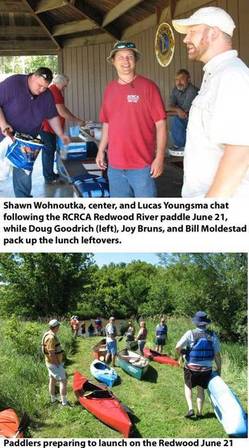 |
DNR paddlers do preliminary Rosgen analysis on the Redwood River
In addition to helping guide paddlers on the Redwood River June 21, DNR Area Hydrologists Lucas Youngsma and Garry Bennett also used the trip to conduct a preliminary Rosgen stream channel classification on that river reach. This classification system identifies common patterns of channel morphology based on the stream valley, channel sinuosity, width to depth ratio, degree of channel entrenchment and the stream bed material. The classification system assists in understanding when river and streams depart from a stable system by changing from one classification to another, through this predictions can be made of what that future condition will likely become and what restoration options are most likely to work on those classification types. Specific objectives of the Rosgen stream classification include:
- Assess the stability or instability of various river reaches and understand the controlling variables accounting for these differences;
- Develop specific hydraulic and sediment relationships by stream type which can be applied to similar stream reaches in the watershed;
- Identify and prioritize restoration and protection strategies on a watershed and sub watershed scale;
- Develop some long term monitoring sites for evaluating future changes;
- Provide a consistent and continuous frame of reference for communicating stream morphology and conditions among a variety of disciplines.
|
|
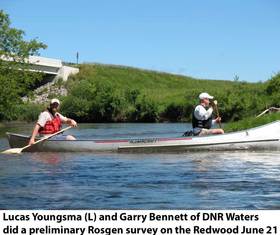 |
Hawk Creek staff back at full strength
Heidi Rauenhorst and Jordan Austin joined the Hawk Creek Watershed Project staff June 4, as coordinator and technician, respectively. A native of the Olivia
area, Heidi previously worked for the DNR and Farm Service Agency. She earned a
B.S. in biology at San Diego State University, and is working toward an M.S. in
biology at Minnesota State-Mankato. A native of Wykoff in southeastern Minnesota, Jordan graduated from Southwest State with a B.S. in environmental science. In 2010 he worked as a summer intern with the Chippewa River Watershed Project. Mark Dunham is the summer intern doing monitoring. A graduate of Willmar High School, he will be a junior at Concordia-Moorhead majoring in biology.
Legvold to speak July 12 at Belgrade
The North Fork Crow River Watershed District has invited Northfield area farmer David Legvold to talk about his sustainable farming practices, 11 a.m., July 12 at the Belgrade VFW. Legvold farms 800 acres with corn, soybeans and beef cattle. He implements many conservation practices on his farm to protect long-term productivity. RSVP to 320-346-2869, or e-mail: nfcrwsd@tds.net.
|
|
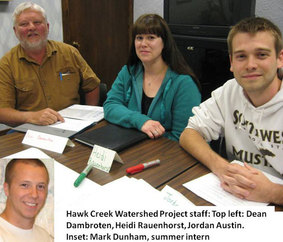 |
Good turn-out at Middle Fork
Crow River open house June 5
EPA approves TMDL report for Rice Lake
The U.S. EPA recently approved the TMDL report for Rice Lake east of Paynesville in Stearns County. Rice Lake is a 1,651 acre lake within the lower region of the North Fork Crow River Watershed District (NFCRWD). The watershed district encompasses about 350 square miles and includes 48 miles of the North Fork Crow River. Land use in the watershed is primarily agricultural. The lake accepts drainage from Pope, Stearns, and Kandiyohi Counties. Rice Lake is impaired by excess nutrients. See the final report on the North Fork Crow River, Rice Lake project webpage.
|
|
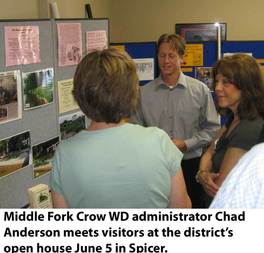 |
|
Just below the protrusion of the western Minnesota border into South Dakota, the Lac qui Parle and Yellow Bank rivers drain a watershed of more than 1,700 square miles. Tumbling from the coteau – Buffalo Ridge – the water descends more than 1,000 feet to Lac qui Parle Lake and the Minnesota River.
In the early days of watershed management, flooding was the main concern. In 1971, the Lac qui Parle-Yellow Bank Watershed District was created to address flooding. Projects such as the state’s largest earthen dam near Canby have alleviated flooding problems, and created Del Clark Lake.
|
|
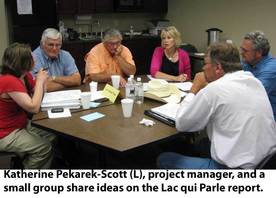 |
Water quality becomes a major focus
More recently, the watershed district is focusing on water quality. On June 4 the district hosted a public meeting to review a Total Maximum Daily Load draft report and implementation plan. About 30 landowners and water management professionals met in Madison to review the report and provide comments.
Instead of the conventional meeting format, much of the discussion occurred in small groups on several topics: Water quality standards, general implementation, cost-share programs, and content of the TMDL report. The report addresses 19 impairments among 11 reaches: Bacteria-11, turbidity-7, and low dissolved oxygen-1. Five comment letters were received during the official public comment period May 29-June 27. More information is available on the MPCA Lac qui Parle River webpage, and the watershed district webpage.
|
|
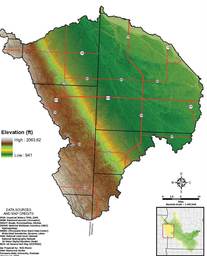 |
Farmer installs coil 'blind' intakes for water quality
Harvey Swenson has removed about three or four open tile intakes on his farm west of Clarkfield, and plans to close more. He described the work at the June 4 meeting of the Lac qui Parle-Yellow Bank Watershed District. In some cases, he is replacing them with large, subsurface coils of tile as a form of blind or buried intake. Replacing open tiles with subsurface intakes can reduce sediment and nutrient loss by up to 50 percent. While he may be eligible for cost-share, for now he is doing it at his own expense - from $200 to $400 each. "If we can clean up the water, it's worth it," Harvey says. Installation involves digging a large diameter hole around the intake, laying down a coil of tile connected to the drain tile opening formerly to the riser, and covering with soil. All intakes are located on GPS, and he owns a backhoe and plans to continue converting more to buried coils.
|
|
 |
Nearly 20 years after discussions began regarding the poor health of the Fulda
Lakes, the Heron Lake Watershed District (HLWD) has earned a state award
recognizing it for efforts to improve water quality and clarity. HLWD administrator Jan Voit and technician Ross Behrends accepted
the Environmental Initiative Award in the Natural Resources Protection and
Restoration category. Winners were announced in each of five categories at an
awards dinner at the Nicollet Island Pavilion in Minnepolis.
The award recognized the HLWD for the “grassroots effort to bring back the
Fulda Lakes” through partnerships with multiple agencies, from the Department of
Natural Resources and U.S. Fish and Wildlife Service to the Fulda Fish and Game
Club, Murray County, Bondin Township, the Heritage Society, City of Fulda,
Minnesota Pollution Control Agency and numerous watershed landowners.
In all, nearly $409,000 was spent by the HLWD and partnering agencies. That
included purchase of farmland near the lake that was converted to native
grasses, wetland restoration, pond cleanout, sediment pond creation, rock
inlets, a grade stabilization project, incentives for conservation tillage and
cost-share for shoreline restorations and rain gardens. - Worthington Daily Globe
|
|
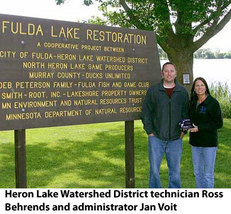 |
Jennifer
Maleitzke was hired in June 2012 as the communications director for the Board of Water and Soil Resources. Previously, she worked for seven
years at the Minnesota Pollution Control Agency, starting in the public
information office and most recently, serving as the administrator for the
Governor’s Clean Water Council and as the agency’s Clean Water Fund
coordinator. Prior to working at MPCA, she spent three years as a
communications specialist for Dakota Woodlands homeless shelter. Maleitzke
holds a master’s degree in public administration from the Hamline
University and a bachelor’s degree in English from Northern State
University. She has obtained certificates for leadership,
facilitation, and public participation. She also is a board member for the MN
Association of Government Communicators.
The MPCA is working on an evaluation of Minnesota’s
water-related laws, rules and programs in order to streamline, strengthen, and
improve water management.
While water governance in Minnesota has been studied and
evaluated since the 1970s, in recent years, the Legacy Amendment and the Clean Water
Fund have served as powerful incentives for state agencies to collaborate and
improve the integration of their programs. However, at the local level, the
complexity of programs and permit requirements often frustrates landowners and
local governments.
This study, authorized by the Legislature during the 2011 special session, represents an effort by the state water management agencies seek opportunities to improve their policies,
processes and requirements.
The study is still in the information-gathering and issue
identification phase, and actively seeking input, opinions and
ideas. Your experience and opinions matter. Please provide your feedback
through this brief
online survey. For more information, contact Suzanne Rhees at 651-757-2030
or suzanne.rhees@state.mn.us.
On June 5, the Legislative-Citizen Commission on Minnesota Resources selected 65 proposals requesting a total of approximately $79 million to invite in to present before the Commission and receive further consideration on June 19, 20, 27, and 28. A total of 169 proposals requesting a total of approximately $155 million were received. Beginning July 1, 2013, approximately $34 million from the Environment and Natural Resources Trust Fund is currently expected to be available to recommend for project funding.
Heron Lake Watershed District, $122,000, Jan Voit: The Heron Lake Sediment and Phosphorus Reduction Implementation Projects would install five water quality improvement projects to reduce sediment and phosphorus to Heron Lake, monitor three streams, distribute one newsletter, and host a field day.
Friends of the Mississippi River, $442,000, Tom Lewanski: Protect, Restore and Enhance Significant Watershed Habitat. FMR will restore 10 acres of prairie and enhance 120 acres of prairie/savanna and 108 acres of forest. Six acres within the Fish Creek Natural Area will be acquired.
Great River Greening, $421,000, Wiley Buck: Restoring Our Lands and Waters Greening will restore/enhance 190 acres (100 Trust Fund) and 2,200 lineal feet (1,300 Trust Fund) of shoreline, engaging 250 volunteer community members in meaningful parts of the work.
Dakota County, $850,000, Alan Singer: The Dakota County Lakeshore and Riparian Protection project will acquire 194 acres of conservation easements along rivers, streams and undeveloped
lakeshore; develop Natural Resource Management Plans for 74 acres and restore/enhance 50 acres.
The Legislative Citizen Commission on Minnesota Resources is made up of 17 members: Five senators, five representatives, five citizens appointed by the governor, one citizen appointed by the Senate, and one citizen appointed by the House. The function of the LCCMR is to make funding recommendations to the legislature for special environment and natural resource projects, primarily from the Environment and Natural Resources Trust Fund (ENRTF). These projects help maintain and enhance Minnesota's environment and natural resources. The LCCMR developed from a program initiated in 1963. Since 1963, over $735 million has been appropriated to more than 1,700 projects recommended to the legislature by the Commission to protect and enhance Minnesota's environment and natural resources.
EPA has released a
new fact sheet as part of its Healthy Watersheds initiative describing the
economic benefits of protecting healthy watersheds by highlighting examples
from existing peer-reviewed literature and studies. EPA’s Healthy Watersheds
Initiative is intended to protect the Nation’s remaining healthy watersheds,
prevent them from becoming impaired, and accelerate restoration successes. It
encourages interested states to take a strategic, systems approach to
protecting healthy watersheds that recognizes the dynamic and interconnected
nature of aquatic ecosystems. The fact sheet is
available at: http://www.epa.gov/healthywatersheds.
Whereas,
several watersheds throughout the state of Minnesota have been classified as
impaired waters, and;
Whereas, Total Maximum Daily Loads (TMDLs) are being used as a measure to
improve water quality in those watersheds,
Therefore, be it resolved, that the Minnesota Holstein Association supports
being proactive in the legislative process and in implementing agricultural best
management practices to reduce non-point source pollution.
The 2012 Minnesota State Holstein Show was held at the McLeod County Fairgrounds in
Hutchinson, Minn. on Saturday, June 23, 2012. Callum McKinvin was the official
judge for the show and placed 101 heifers and 97 cows for a total of 198
head.
News release, 6/20/12
News release, 6/18/12
MPR, 6/13/12
Agri-News, 5/31/12
Agri-News, 5/31/12
Worthington Daily Globe, 6/2/12
June 29-July 1: Dawson Riverfest.
July 11: Friendship
Tour, upper Minnesota River basin, Ortonville, info: 320-839-3411.
July 12: Seminar: Role of seepage and preferential flow on streambank failure and gully erosion, Dr. Glenn Wilson, 1 p.m., Minnesota State student union, room 238.
July 12: David Legvold - "View from the tractor seat," 11 a.m. Belgrade VFW.
July 16: Minnesota
River Board, 9 a.m., St. Peter Community Center.
July 28-29: Mississippi River Challenge,
|
Watershed Projects
Watershed Districts
Joint Powers Boards and Associations
Citizen/Organizations
|
|
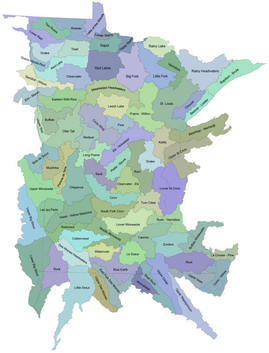 |
Watershed Network News
welcomes news from partners about funding opportunities, project updates and
events. Email your news to forrest.peterson@state.mn.us. Please note
that the MPCA has switched to a new service, called GovDelivery. To ensure
delivery of these messages, please add mpca@public.govdelivery.com
to your address book or safe sender list. Please forward this to any other
interested parties. Past issues are located on the Watershed Network publications
webpage.
|
|
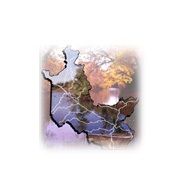 |
|